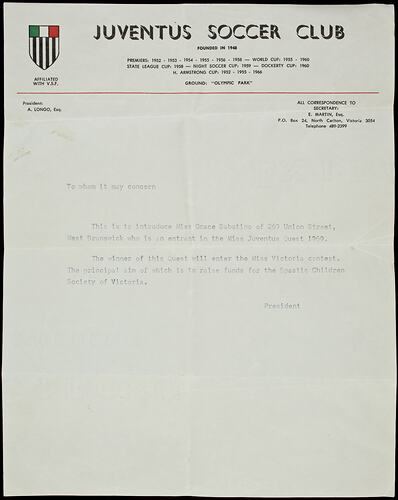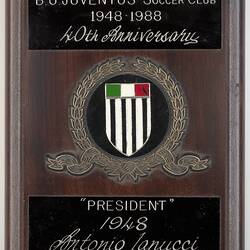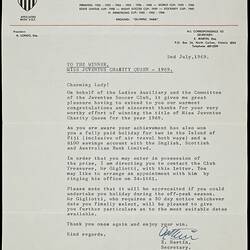Summary
Letter of introduction printed on Juventus Soccer Club masthead. The unsigned letter from the President introduces Miss Grace Sabatino from West Brunswick as a Miss Juventus Quest entrant in 1969. It states that the contest winner will enter the Miss Victoria contest and that the aim of the quest is to raise funds for the Spastic Children Society of Victoria.
From the 1950s to 1970s, Juventus Soccer Club (now the Brunswick United Juventus Soccer Club) was an important focal point for the Melbourne and Victorian Italian communities. Founded in 1948, its forerunner was the Savoia Club which existed during the 1930s until disbanded after the outbreak of World War II. After a meeting at St Georges' Hall at Sacred Heart church in Carlton a resolution was made to re-establish the Italian soccer team and open player membership to all. Rino Fontana is generally viewed as the club founder. Juventus was decided as a club name of political and regional neutrality, and playing jumpers were to be black and white stripes. The club played its first match in Brighton at Hurlingham Park. The team enjoyed great success but declined during the 1970s due to internal problems, the formation of the National League and their non-competitiveness. Juventus finally joined the national competition in 1984 but was demoted to the State League at the end of 1988. Its home ground in Victoria Street Brunswick was completed in 1989.
Physical Description
Hand typed letter on cream paper with the Juventus Soccer Club masthead which includes a black and white striped crest and green, white and red colours of the Italian flag.
Significance
This letter compliments a small collection of objects relating to the Juventus Soccer Club, a sporting club of enormous social and cultural significance for the Victorian Italian community. These letters demonstrate the important associated activities that were organised as community get togethers and fundraisers which provided opportunities for first and second generations members of migrant communities to gather and socialise. The letters also offer an interesting insight into the tradition of beauty and charity queens which acted as popular fundraisers and also acceptable avenues for young women to mix and interact.
More Information
-
Collecting Areas
-
Acquisition Information
Donation from Ms Carole Fabian - Brunswick Zebras Football Club, 04 Jun 2010
-
Organisation Named
Juventus Soccer Club, North Carlton, Victoria, Australia, 1969
-
Inscriptions
'To whom it may concern' Sign off 'President'
-
Classification
-
Category
-
Discipline
-
Type of item
-
Overall Dimensions
205 mm (Width), 260 mm (Height)
-
Keywords
Beauty Contests, Italian Communities, Italian Immigration, Sporting Clubs


